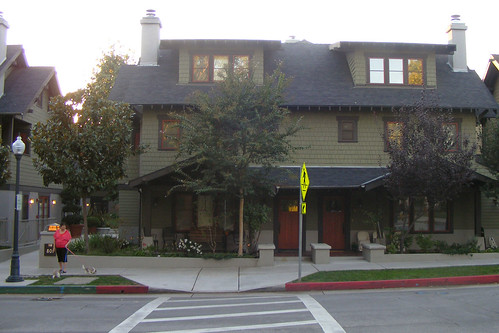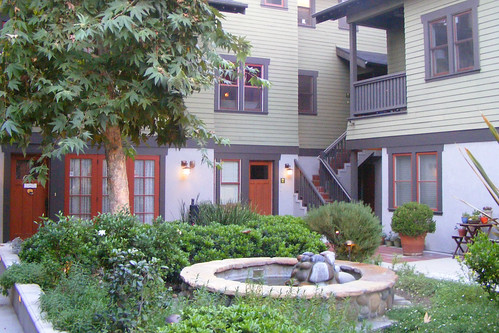First of a series of posts from this year's Rail~Volution conference in Los Angeles.
 |
| Commercial building and duplexes at Mission Meridian Village. |
It's commonly accepted that we should build up around public transit, but how can you do it in a way that respects existing neighborhoods? Yesterday, I visited
Mission Meridian Village in South Pasadena, a project that shows how to do just that.
Designed by New Urbanist architects
Moule & Polyzoides and developed in a public-private partnership between the city and
Creative Housing Associates, Mission Meridian Village opened in 2003 across from the then-new South Pasadena Gold Line station, which connects to downtown Los Angeles.
 |
| A duplex at Mission Meridian Village. |
The project is located next just off of Mission Street, a quaint shopping district like Old Town Takoma Park where light-rail trains glide past coffeehouses and bakeries. Closer to Mission Street is a larger commercial building with shops and loft apartments, while behind it are a mix of apartments, townhomes, and single-family homes that seem to blend into the surrounding neighborhood of humble Craftsman bungalows. An underground parking garage, with spaces for residents and commuters, runs under the entire site.
From the street,
you see a row of duplexes, each of which has a similar scale and uses the same materials as existing homes. The only hint that these aren't ordinary houses are
the little paths that lead into 3 lush courtyards, where you'll find entrances to the other homes.
 |
| Inside one of the courtyards. |
All of this happens on 1.65 acres, about a fourth bigger than a football field. With about 67 homes, Mission Meridian Village has a density of 40 homes per acre, but it doesn't feel crowded. Each house
has its own private outdoor space, be it a porch, a patio or a balcony. Meanwhile, residents have eagerly embraced the shared courtyards. Chairs and tables spill out from patios into the space, while kids' toys lie on the ground, waiting for the next game.
Mission Meridian Village is a great example of how to provide much-needed housing in a way that gives residents open space and a feeling of community. It's also an example for
how to build better suburban neighborhoods where a car isn't mandatory. Most importantly, however, it's an example of how to add to a community while respecting what's already there.
Check out
this slideshow of Mission Meridian Village.




2 comments:
My questions:
Is how many parking units are provided per unit?
Is it all in the underground lot?
Is parking free to the residents?
Who owns the garage and thus repsonsible for its upkeep?
Has the provided amount of parking proved adequate?
Just cause you may not 'need' a car does not mean that most will forego owning one.
I lived on 16th St in the District for 5 years and worked in town but kept my car.
Post a Comment